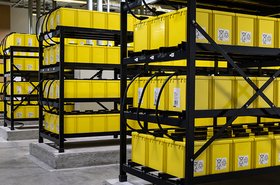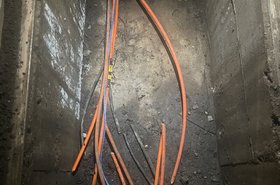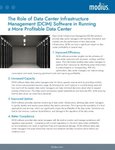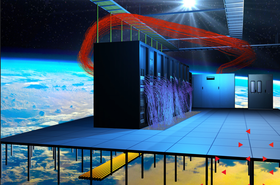Lithium-ion (Li-ion) batteries have grown in popularity as backup energy storage in data centers due to significant improvements in their performance, lifespan, and energy density. They also take up less space in a data center and need replacing less often than long-established lead-acid units.
However, Li-ion batteries are vulnerable to thermal runaways that, if left unchecked, can result in powerful fires. The rapid adoption of this technology has added a new type of risk that the data center sector may not be fully accounted for — the data and experience are still limited.
Even if data center operators assess the risks to be manageable, the use of Li-ion batteries may still attract increased costs due to more robust fire prevention, and more onerous permitting and insurance premiums.
The risk of fire
Li-ion batteries are prone to destructive and hard-to-control fires. There have been several reported incidents in data centers, some of which have led to serious outages, but they are not well-documented or systematically studied.
The most widely-reported outage caused by a Li-ion fire was in 2022 at SK Group’s C&C subsidiary in Pangyo, South Korea. The fire started in the battery room before spreading quickly to the rest of the building. The incident brought down the KakaoTalk messaging platform, which included an integrated mobile payment system used by millions.
In 2023, reports that a Li-ion fire destroyed a 6MW data center were disclosed to Uptime Institute, but the details have not been made public.
In other incidents, such as the Khawaja Tower fire in Dhaka, Bangladesh, that killed three people, the causes have not been revealed, but batteries are most likely a factor.
It is clear from this data that outages or damage resulting from Li-ion battery fires are rare, but they do happen. Understanding and managing this risk is essential for data center operators, as a lack of understanding can increase the risk.
One common issue for operators is a mismatch between a fire suppression agent and the type of fire. Some common fire extinguishing methods, notably the inert gas and hypoxic systems installed in many data centers, are not fully effective at suppressing Li-ion battery fires.
Uptime Intelligence is aware of multiple facilities where the battery room has no fire suppression system, or where it is not appropriate for tackling a Li-ion fire.
This has led to incidents of Li-ion battery fires that could have been avoided.
Li-ion battery manufacturers are aware of the issue — they already ship units with battery management systems and thermal monitoring. In some cases, these may prove insufficient on their own but can trigger other effective measures before an unstoppable fire takes hold. Data center operators should also be aware that manufacturers’ standards for Li-ion batteries may vary widely and that manufacturing faults are one of the causes of Li-ion battery fires.
UPS vendors have told the Uptime Institute that they choose battery technology based on its inbuilt management functions, aiming to provide a system with good inherent safety. Beyond this, vendors say the essential next step — a fire suppression system tailored to the specific installed Li-ion system — is left to the customer.
There are some concerns that the fire suppression demands of Li-ion battery systems are not sufficiently understood and that data center operators may be cutting corners or relying on insufficient or inappropriate fire suppression due to a lack of knowledge. Uptime Intelligence will shortly publish a report on Li-ion fire suppression methods and systems.
As Li-ion becomes more widespread, prices fall, and competition increases, there is a risk that cost-cutting by battery makers and UPS vendors will lead to higher risks.
Response from fire authorities
Formal standards for fire safety are belatedly catching up with the rise in use of Li-ion batteries as fires in consumer devices draw attention to the issue. In 2023, the Fire Safety Research Institute and the Fire Department of the City of New York called a spate of high-profile home fires in the city that were caused by electric scooters “alarming.”
Fire services are aware that data centers now contain Li-ion batteries. In 2023, the US Society of Fire Protection Engineers (SFPE) warned its members that Li-ion battery use in data centers will lead to more calls to emergency responders and that fires will become more severe and dangerous. SFPE also noted that normal facility access restrictions will make the job harder for first responders.
“While the rate of individual Li-ion cell failures is typically quoted as rates of ‘1 in 1 million’ to ‘1 in 10 million,’ data centers have become so large that one data center may contain millions of Li-ion cells,” said SFPE. “Fire safety standards, building codes, and the safety of Li-ion batteries are improving, but fire department responses to data center battery incidents are likely to increase in frequency until the hazards can be engineered out.”
In some countries — notably the US — the UL 9540 standard, originally designed for energy storage systems (ESS) used in grid balancing, is now being cited in relation to the UPS systems used in data centers.
The basic version of UL 9540 says that an ESS should be made up of units no larger than 50 kilowatt-hours. These must be placed at least three feet (about 90 cm) apart and at least three feet (about 90 cm) from any adjacent room wall to prevent the spread of any fire. It is likely that this spacing would negate the space-saving benefits of Li-ion batteries.
The UL standard does allow some exceptions, including larger units placed closer together, if large-scale tests have been carried out in accordance with the UL 9540 test method, known as UL 9540A. The test includes an assessment of flammable gas release data, which can be used to design a specific explosion control system. The results specify installation requirements, ventilation instructions, and any special procedures that the fire service should follow.
Safety officials in the US (Authorities Having Jurisdiction, or AHJs) have a lot of autonomy within their local area and it is widely expected that they will start implementing significant regulatory changes. These officials are reported to be telegraphing that there will be stricter regulations around the use of Li-ion batteries. The issue has been likened to that of gas stations, with the suggestion for a similar set of restrictions to apply to Li-ion battery installations.
Some facilities have opted for different battery chemistries to forestall regulatory issues.
Tighter regulations could rule out the use of Li-ion batteries in new projects in some locations or potentially require their removal if already in situ. If data center deployments are not grandfathered or exempted, then the batteries at existing sites would have to be removed and replaced, or the facilities retrofitted with UL9540-compliant rooms, which would be a costly operation.
Exaggerated risks?
While preparing this report, we heard very few operators express any hesitations about using properly installed Li-ion batteries — although all were aware of some of the risks. UPS vendors also have no qualms about selling them, arguing that the fire risk is in fact carefully understood and well covered.
A commonly held view is that Li-ion’s fire risk in the data center is overstated, partly as a result of marketing by vendors of alternative chemistries such as salt and nickel-zinc. If these products are promoted as a “safe” alternative, then it will (it is speculated) create a perception that Li-ion is “unsafe.”
After assessing the evidence, examining the science, and hearing from data center operators at recent member meetings, Uptime Institute is taking a cautious and practicable stance at this point.
While it is true that Li-ion batteries have a higher risk of fire compared with other chemistries, and these fires are particularly problematic, Uptime Institute engineers do not think Li-ion batteries should be rejected out of hand. Li-ion batteries have significant performance and cost benefits when used in carefully controlled settings.
However, operators adopting the use of Li-ion batteries in their data centers should do so with their eyes open. They should be aware of the risks and follow the best practices for their use.
Best practice
Data center builders and operators should carefully consider the benefits of Li-ion batteries alongside the risks. As well as the obvious risk of serious fires, there are financial and reputational risks in preparing for, avoiding, and responding to such incidents.
The cost of these measures should be factored into the financial analysis of Li-ion batteries — along with the possibility that changes may be required in the future.
Alternatives should also be evaluated.
Alternative battery types
Within the Li-ion family, there are variations based on the metal used for the cathode: lithium iron phosphate (lithium ferrophosphate, or LFP) and lithium nickel manganese cobalt oxide (NMC) are the most popular chemistries for static storage applications such as UPS battery rooms. Of these, NMC is denser, while LFP is cheaper.
Data center operators will need to carry out their own assessment of the appropriate battery type and its built-in thermal management.
As an alternative to Li-ion, some manufacturers have explored newer chemistries, including nickel-zinc and sodium. These technologies are not as well proven and productized, do not have economies of scale and will likely cost more. Also, they currently do not have the mature supply chain of mainstream Li-ion batteries, so future upgrades and support may be in question.
The option to stay with lead-acid batteries should also not be overlooked. Technology developments have continued in this area and newer types, such as thin plate pure lead batteries, have a longer lifespan and faster recharge times than other lead-acid battery types.
Newer lead-acid battery types have a higher price along with their improved performance, so they require a similar total cost of ownership analysis to Li-ion units.
Lead-acid batteries are arguably “greener” because they can be easily recycled and do not use scarce minerals that are needed elsewhere.
Fire prevention and suppression
Li-ion battery units are shipped with battery management systems and thermal monitoring, which are designed to trigger effective measures before an unstoppable fire takes hold. These provisions work in tandem with fire suppression tools.
Data center operators will need to assess the thermal management functions of their Li-ion batteries and carry out their own assessment of which fire suppression equipment to use, independent of any recommendations from the UPS vendor.
Battery rooms should be fitted with fire management methods that work effectively on Li-ion batteries. These include specialized fire suppression agents, such as Novec 1230 and FM-200, or dry chemicals, such as potassium bicarbonate. Water mist systems can also be used: these produce very fine droplets that cool the burning batteries without creating thermal shock or reactions.
Another technique used specifically to tackle Li-ion fires is an aqueous suspension of vermiculite, which is sprayed onto the batteries. In this approach, the water evaporates, cooling the battery and creating a layer of thermal and electrical insulation.
Note that there is considerable debate surrounding the relative efficacy of different suppression techniques — these will be discussed in a forthcoming report.
Installation and training
Data center operators should be aware that even fire suppression systems designed for Li-ion batteries may not be 100 percent effective. Also, there is a finite possibility that a facility may experience conditions that make battery breakdown and thermal runaway inevitable. These include short circuits and severe heat (the latter being more likely in some geographies than others).
The 6MW data center mentioned earlier is a case in point. It experienced a devastating Li-ion battery fire, despite having a Novec-based fire suppression system that is designed to work with Li-ion batteries.
For this reason, Li-ion batteries should be isolated from staff and white space equipment. If possible, they should be housed in a separate building, or at the very least in fire-resistant enclosures with a containment system to prevent fire spreading.
If Li-ion batteries are installed in existing buildings, these structural measures are still required.
Staff should be trained in how to respond to a Li-ion battery fire, including evacuation and the use of specialist equipment. They should also be ready to communicate well with emergency responders to ensure they know that a Li-ion fire is in progress and act appropriately.
Regulations and insurance
Data center operators should investigate the fire regulations in their area as well as any changes resulting from recently-reported Li-ion incidents. Assessing the likelihood of costly changes is important — but can be difficult.
Finally, and crucially, operators need to talk to their insurers. Li-ion batteries introduce new risks into a data center. It is the operator’s responsibility to discuss these with the insurer. If the operators do not, they risk invalidating their insurance.
At least one operator reports that a decision was made to reject the adoption of Li-ion based partly on advice from their insurer.










